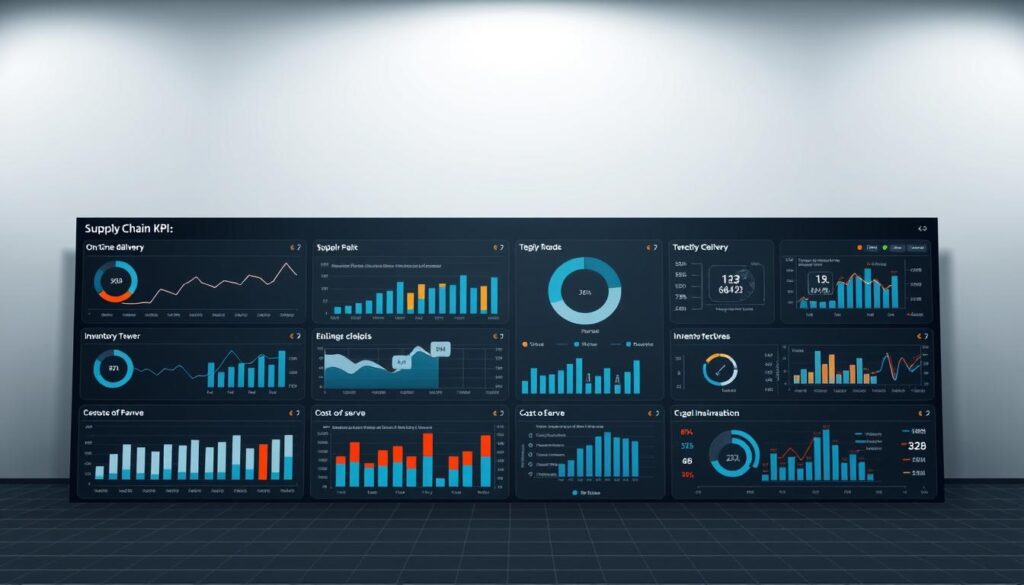Now Reading: Real-World Blockchain in Supply Chain Management Case Studies
- 01
Real-World Blockchain in Supply Chain Management Case Studies
Real-World Blockchain in Supply Chain Management Case Studies

Global trade networks face immense pressure. They must move goods faster, cheaper, and with greater visibility than ever before. Recent global disruptions exposed critical weaknesses in traditional models.
This created an urgent need for robust technological solutions. Innovative systems are now stepping up to meet this demand. They offer new ways to build trust and efficiency across complex partner ecosystems.
This article explores documented implementations from leading companies. We will see how they use advanced digital ledgers to solve real problems. These problems include tracking items from origin to consumer and verifying ethical sourcing.
The following sections provide a comprehensive look at the fundamentals. We examine the challenges of adoption and the measurable outcomes achieved. The goal is to offer practical insights from those who have already begun this transformative journey.
Key Takeaways
- Global disruptions have accelerated the adoption of advanced technological solutions in logistics.
- Distributed ledger systems provide unprecedented transparency and traceability for goods.
- Real-world implementations demonstrate practical solutions to long-standing operational inefficiencies.
- This technology is increasingly viewed as essential infrastructure for modern global trade.
- Documented case studies offer valuable lessons on implementation challenges and successful outcomes.
- These systems help organizations manage risk and meet growing demands for ethical and sustainable practices.
Introduction to Blockchain in Supply Chain Management
Consumer goods shortages during the pandemic revealed fundamental flaws in modern logistics. From everyday essentials to electronics, delivery delays exposed systemic weaknesses. Traditional models built on just-in-time principles proved vulnerable to multiple threats.
Executive priorities have shifted toward three critical areas. These include risk prediction, ESG compliance tracking, and building trust across complex partnerships. This strategic redirection addresses the fragility exposed by recent disruptions.
| Traditional Approach | Modern Solution | Key Benefits |
|---|---|---|
| Centralized databases | Distributed ledger systems | Enhanced visibility |
| Manual verification | Automated validation | Reduced errors |
| Limited access control | Permission-based sharing | Secure collaboration |
| Separate record keeping | Single source of truth | Improved accuracy |
The technology functions as a shared digital record that cannot be easily altered. It provides a trusted method for recording transactions across multiple organizations. This creates transparency that centralized systems cannot match.
According to Deloitte’s research, this approach complements existing enterprise systems rather than replacing them. It enhances value while maintaining current operational frameworks. The result is more resilient networks capable of withstanding future challenges.
Blockchain Technology Fundamentals for Supply Chains
At its foundation, this innovative approach to data management relies on decentralization, consensus protocols, and cryptographic security. These three principles work together to create systems that are transparent, tamper-resistant, and efficient.
Decentralization and Consensus Mechanisms
Unlike traditional databases controlled by single entities, distributed ledgers operate across peer-to-peer networks. Each participant maintains a complete copy of transaction history. This eliminates single points of failure.
Consensus mechanisms validate transactions across the network. Proof of Work requires solving complex mathematical problems. Proof of Stake selects validators based on their stake in the system.
| Blockchain Type | Access Level | Ideal Use Case |
|---|---|---|
| Public | Anyone can join | Cryptocurrency transactions |
| Private | Restricted membership | Internal business processes |
| Consortium | Multiple organizations | Supply chain collaboration |
The Role of Smart Contracts
Smart contracts are self-executing agreements stored on the ledger. They automatically trigger actions when predefined conditions are met. This reduces the need for intermediaries and minimizes human error.
These automated contracts enable complex business logic without manual intervention. They provide unprecedented automation capabilities for multi-party transactions.
Enhancing Transparency and Traceability in Supply Chains
A critical weakness in contemporary trade systems is the difficulty in verifying the origin and journey of products. Distributed ledger technology directly tackles this by creating an unchangeable record visible to all authorized partners.
This real-time visibility eliminates information gaps. It allows companies to spot potential disruptions early.
Reducing Administrative Costs through Automation
Manual data entry and reconciliation between companies create significant expense and delay. Automated smart contracts streamline these processes.
They execute agreements automatically when conditions are met. This reduces errors and cuts down on paperwork.
The result is a single, trusted source of truth. Partners spend less time arguing over data and more time on value-added work. This automation leads to substantial cost savings across the entire network.
Case Study: Real-Time Shipment Tracking with Blockchain and IoT
Deloitte’s innovative approach to shipment visibility demonstrates how digital ledgers transform cargo tracking. Their prototype addresses a critical gap in international logistics.

Implementation Approach and Technology Integration
The solution combines three powerful components. Hyperledger Fabric provides the foundation for the distributed ledger system. Thingstream positioning trackers capture location data over GSM networks.
AWS cloud infrastructure handles the computational workload. Sensors attached to pallets automatically transmit position information. This eliminates manual updates and human error.
| Traditional Method | New Approach | Key Improvement |
|---|---|---|
| Manual location reporting | Automatic sensor tracking | Real-time accuracy |
| Separate company records | Shared digital ledger | Single source of truth |
| Delayed data updates | Instant transmission | Immediate visibility |
| Vulnerable to tampering | Immutable records | Enhanced security |
Impact on Tracking and Data Integrity
The system creates trusted shipment histories accessible to all authorized parties. Senders, shippers, and receivers view the same verified information.
Data integrity is maintained through cryptographic protection. No single participant can alter historical records without detection. This builds confidence across the entire network.
Real-time monitoring enables proactive problem-solving. Delays or route deviations are identified immediately. The technology represents a significant step toward comprehensive logistics solutions.
Case Study: Simplifying Patient Consent and Biosample Management
Healthcare research organizations struggle with fragmented data systems when handling sensitive patient materials. Clinical trials involve complex workflows across multiple stakeholders. This creates significant challenges for maintaining consent integrity.
Deloitte developed the BioTrack & Trace proof of concept to address these issues. This innovative application consolidates previously isolated clinical processes onto a shared platform.
Developing a Blockchain-Based Proof of Concept
The solution brings together consent documentation, sample collection, storage, and analysis workflows. It creates a unified system for doctors, trial sites, and researchers. This eliminates information gaps between independent actors.
| Traditional Approach | BioTrack & Trace Solution | Key Improvement |
|---|---|---|
| Separate consent records | Unified consent tracking | Continuous verification |
| Manual sample logging | Automated data entry | Reduced errors |
| Limited access control | Permission-based sharing | Secure collaboration |
| Fragmented storage systems | Centralized management | Complete visibility |
Benefits for Clinical Trials
Operations teams can track each sample’s precise location and usage history. Scientists gain immediate access to complete collection data. This enhances both regulatory compliance and patient protection.
The blockchain application provides essential audit trails for sensitive medical research. It represents a significant advancement in clinical data management practices.
blockchain in supply chain management case studies
Documented implementations reveal powerful patterns across diverse business sectors. Companies achieve measurable improvements through strategic technology adoption. These projects demonstrate practical solutions to long-standing operational challenges.

Successful initiatives typically focus on specific objectives. These include enhancing visibility, improving product tracking, and reducing administrative costs. Each sector adapts the technology to address unique requirements.
The food industry prioritizes freshness verification and contamination prevention. Pharmaceutical companies focus on drug authenticity and temperature control. Automotive manufacturers track parts provenance and quality assurance.
Effective implementations share common characteristics. They begin with clear business value propositions and appropriate platform selection. Multi-stakeholder collaboration proves essential for network effects.
Companies measure success through specific metrics. These include reduced processing times, fewer disputes, and improved customer confidence. Many documented implementations show significant return on investment.
Projects evolve from small pilots to full-scale systems. They gradually expand transaction volume and participant numbers. This phased approach allows for continuous improvement and adaptation.
The most successful initiatives maintain realistic expectations about complexity. They invest in change management and data governance frameworks. These factors distinguish sustainable implementations from temporary experiments.
Integrating IoT, AI, and Other Emerging Technologies
The true power of distributed ledger systems emerges when they combine forces with other digital innovations. These platforms achieve maximum impact through strategic combinations rather than standalone operation. Modern applications function as orchestration layers that coordinate multiple technological components.
Internet of Things devices generate continuous data streams about product conditions and movements. Sensors track location, temperature, handling events, and quality parameters. This real-time information feeds directly into digital ledgers for permanent recording.
Leveraging Smart Contracts for Automation
Self-executing code transforms how businesses handle transactions and agreements. These automated contracts trigger actions when predefined conditions are verified. Payments can release automatically when goods reach specific locations or pass quality checks.
Artificial intelligence applications analyze the immutable data stored on these platforms. Machine learning algorithms identify patterns and predict potential disruptions. This enables proactive interventions before problems escalate into costly delays.
The integration creates capabilities impossible with any single solution alone. It reduces manual intervention requirements and minimizes human errors. Cycle times accelerate significantly in time-sensitive industries like automotive and electronics manufacturing.
Technical architectures enable seamless collaboration between these components. Data oracles feed external information onto distributed ledgers. AI systems access verified records for advanced analytics and decision support.
Security and Privacy Considerations in Blockchain Applications
Enterprise adoption of advanced technologies necessitates robust frameworks for safeguarding sensitive information. Organizations must evaluate potential vulnerabilities across four key areas when implementing distributed ledger solutions.

These risk categories include confidentiality protection, data integrity maintenance, consensus mechanism security, and smart contract vulnerabilities. Each dimension requires specific mitigation strategies.
Identifying and Mitigating Security Risks
The technology ecosystem has matured significantly in response to past security incidents. Industry-wide standards and frameworks now provide guidance for secure implementation.
Companies like OpenZeppelin and CertiK offer standardized smart contract libraries with verified security properties. These pre-audited components help developers implement common logic safely.
Ethereum Request for Comment (ERC) standards represent industry-accepted guidelines for building secure on-chain applications. Bug bounty programs incentivize researchers to identify vulnerabilities before malicious actors can exploit them.
Establishing Industry Standards
Specialized audit firms help enterprises thoroughly vet their code before production deployment. These professionals identify security flaws and recommend improvements.
Organizations should incorporate IT and cybersecurity partners throughout the entire solution lifecycle. This includes exploration, design, adoption, and ongoing operation phases.
This collaborative approach effectively mitigates risks while protecting sensitive supply chain information. The result is more secure implementations that build trust across business networks.
Interoperability and Scalability Challenges in Modern Blockchains
The journey toward seamless digital integration faces significant roadblocks in achieving universal connectivity and processing capacity. Different platforms often operate in isolation, creating compatibility issues across business ecosystems.
Universal standards remain essential for true technological harmony. They enable diverse applications to communicate effectively.
Cross-Chain Solutions and Bridges
Bridge architectures connect separate networks through smart contracts and relay mechanisms. These tools transmit information between different technological environments.
Architectural decisions involve important trade-offs. Decentralized relay networks offer enhanced security but require more resources. Trusted entity relayers provide efficiency but depend on established trust relationships.
Processing large transaction volumes presents another fundamental challenge. Public networks face constraints related to computational power and storage requirements. These limitations can result in delays and increased costs during peak usage.
Various technical approaches address these capacity issues. Layer 1 improvements include novel consensus mechanisms and sharding techniques. High-performance alternatives prioritize throughput while making decentralization compromises.
Layer 2 scaling solutions bundle transactions before recording them on base chains. This approach significantly increases processing capacity while maintaining security foundations.
The blockchain trilemma highlights the difficulty of achieving decentralization, security, and scalability simultaneously. Different solutions make distinct trade-offs among these three dimensions.
Ecosystem participants must collectively assess risk tolerance and performance needs. Their choices determine the most appropriate interoperability and scalability approaches for specific network requirements.
Enterprise Blockchain Solutions for Collaborative Networks
Enterprise-focused digital ledgers provide the framework for trusted business collaboration. These specialized systems create private environments where multiple companies can work together securely. No single organization controls the entire network.
These solutions maintain essential characteristics like security and immutability. They offer controlled access to authorized participants only. This approach preserves distributed trust architectures while protecting sensitive information.
Data governance becomes more manageable in multi-organizational settings. Enterprise systems establish clear ownership and modification rights. They create audit trails that reveal unauthorized access attempts.
The technology strikes a careful balance between transparency and privacy. All participants can view relevant transactions while competitive details remain protected. This makes enterprise solutions ideal for streamlining operations.
Popular platforms include Hyperledger Fabric, R3 Corda, and Quorum. Each offers distinct features for different business scenarios. These systems represent the most practical architecture for most applications.
Enterprise blockchains address concerns about transaction privacy and regulatory compliance. They deliver core benefits while meeting business requirements that public systems cannot satisfy.
Case Study: Walmart and Hyperledger in Food Traceability
Walmart’s journey into advanced traceability began with a simple, yet revealing, test involving a package of mangoes. Frank Yiannas, then Vice President of Food Safety, challenged his team to trace the fruit’s origin using their existing systems. The process took nearly a week, highlighting a critical vulnerability.
This experience spurred the retail giant to explore new solutions. After evaluating options, Walmart Technology selected Hyperledger Fabric. This platform offered the enterprise-grade, permissioned architecture they required.
From Proof of Concept to Production
In 2016, the company launched two pilot projects. One tracked mangoes in the United States, while the other followed pork in China. The results were transformative.
| Product | Location | Traceability Improvement |
|---|---|---|
| Mangoes | United States | From 7 days to 2.2 seconds |
| Pork | China | Enhanced certificate authenticity |
The success of these pilots led to a major expansion. Walmart collaborated with IBM and other industry leaders like Nestle and Unilever. Together, they established the IBM Food Trust network.
Lessons in Supply Chain Transparency
The business case became starkly clear during food safety scares. Past E. coli outbreaks in romaine lettuce forced the disposal of millions of products. Better traceability allows for a targeted response.
This protects consumer health by enabling faster recalls. It also safeguards farmers’ livelihoods. Only contaminated batches need removal, not entire regions. This implementation rebuilt customer confidence through demonstrable safety.
Success Measurement: KPIs and Evaluation Methods
Measuring the actual return on investment from technological innovations requires sophisticated evaluation frameworks that capture both quantitative and qualitative impacts. Many organizations struggle to systematically assess the value created by their digital initiatives.

The complexity stems from multiple interdependent factors. Success depends on specific use cases, data quality, and stakeholder acceptance across the network.
Key Performance Indicators in SCM
Companies typically focus on three core improvement areas when evaluating their technological implementations. These dimensions include transparency enhancement, operational efficiency gains, and network resilience strengthening.
Quantitative metrics provide concrete evidence of impact. Organizations track traceability time reduction and administrative cost savings. Error rate decreases and dispute resolution acceleration also serve as critical indicators.
| Measurement Dimension | Quantitative KPIs | Qualitative Indicators | Business Impact |
|---|---|---|---|
| Transparency | Traceability time reduction | Partner satisfaction levels | Enhanced trust across network |
| Efficiency | Processing time improvement | Regulatory compliance ease | Cost reduction and speed |
| Resilience | Dispute resolution rate | Customer confidence scores | Risk mitigation capability |
Qualitative measures complement numerical data. These include partner satisfaction surveys and customer confidence assessments. Regulatory compliance ease represents another important qualitative factor.
Current research lacks comprehensive methodologies for small and medium-sized enterprises. Establishing causal relationships remains challenging due to multiple influencing factors. Organizations must develop tailored measurement approaches aligned with specific objectives.
Overcoming Implementation Challenges in Blockchain SCM
Companies seeking to enhance their operational capabilities through modern technologies must navigate complex implementation landscapes. Success requires addressing both technical and organizational hurdles.
Integrating Legacy Systems and New Technologies
Digital ledger solutions function as complementary infrastructure rather than replacement technology. They add value while maintaining existing enterprise resource planning platforms.
Integration approaches enable smooth interoperability with current operational frameworks. APIs, middleware layers, and data synchronization mechanisms preserve established workflows.
Organizational hurdles include stakeholder alignment and change management requirements. Skills gaps and personnel resistance to new processes present additional obstacles.
Regulatory uncertainty remains a significant barrier across sectors. Inconsistent legislation creates reluctance among businesses to invest in innovative solutions.
Cost and complexity pose particular challenges for smaller enterprises. Practical mitigation strategies include consortium participation and phased pilot approaches.
Thorough cost-benefit analyses should inform investment decisions. Supply chain leaders must facilitate discussions with internal and external stakeholders.
Future Trends: Blockchain Impact on Sustainability and Resilience
Corporate responsibility now extends beyond profit margins to encompass environmental stewardship and social accountability. Digital ledger systems provide the verification framework needed for this expanded mission. They create immutable records that support genuine sustainability claims.
This technology enables comprehensive tracking of material flows and carbon emissions throughout product lifecycles. Companies can document environmental impact with unprecedented accuracy. Consumers receive transparent information about ecological footprints.
Circular economy models benefit significantly from these capabilities. Tracking components and material composition enables effective recycling and remanufacturing. Ownership histories become permanently accessible for resource recovery initiatives.
Fair trade and ethical sourcing validations gain stronger foundations through this approach. The system creates trustworthy records of labor conditions and supplier practices. Certification authenticity becomes verifiable by all stakeholders.
Operational resilience transforms from reactive to predictive through enhanced visibility. Combined with artificial intelligence, these systems identify vulnerabilities before disruptions occur. This represents a fundamental shift in risk management strategy.
The future impact will address growing demands for environmental responsibility and social accountability. Climate change and geopolitical instability make these capabilities increasingly valuable. Businesses that adopt these solutions will build stronger, more trustworthy networks.
Industry Insights: Lessons from Deloitte-Led Blockchain Projects
Cross-industry collaborations demonstrate how advanced technologies reshape traditional business processes. Deloitte’s work with various organizations provides valuable lessons for digital transformation.
Their approach focuses on helping enterprises build digital networks that address current and future challenges. The firm’s projects span multiple sectors, offering diverse implementation experiences.
Driving Innovation across Supply Chains
Deloitte’s real-time tracking initiative combined distributed ledger technology with IoT devices and cloud platforms. This integration created a comprehensive solution for shipment visibility. The project highlights the importance of selecting complementary technologies that work together seamlessly.
The BioTrack & Trace clinical trials application shows how these principles extend beyond traditional logistics. It addresses complex multi-stakeholder processes requiring verified consent and custody documentation. This demonstrates the technology’s versatility across different operational environments.
Open-source platforms like Hyperledger provide significant advantages for collaborative solutions. Walmart’s experience showed that community support accelerates implementation. Vendor-neutral systems enable participation from suppliers, partners, and even competitors.
Successful implementations begin with clear business problems rather than technology-first approaches. They involve early stakeholder engagement and realistic integration planning. Leveraging established platforms proves more effective than building custom solutions from scratch.
Conclusion
The journey toward transparent global commerce has reached a critical turning point with practical technological solutions. Real-world implementations demonstrate that distributed ledger systems deliver measurable improvements across diverse industries.
Companies achieve dramatic traceability enhancements, reducing tracking times from days to seconds. Multi-stakeholder networks gain unprecedented visibility while automated processes streamline operations. These tangible benefits prove the technology’s value beyond theoretical potential.
Successful adoptions share common traits: clear business objectives, stakeholder alignment, and appropriate architecture choices. Organizations must address scalability and integration challenges through careful planning. The future will see deeper integration with complementary technologies for sustainability tracking.
This approach serves as complementary infrastructure rather than replacement technology. Businesses should begin with specific use cases and learn from documented implementations. For deeper insights into building transparent supply chains, explore our comprehensive resources.
FAQ
How does blockchain technology improve supply chain transparency?
This technology creates an unchangeable, shared record of a product’s journey. Every transaction or movement is recorded, giving all authorized parties a single source of truth. This greatly reduces fraud and errors, building trust among businesses and customers.
What are smart contracts and how are they used in logistics?
Smart contracts are self-executing agreements with terms written directly into code. In logistics, they can automate payments upon delivery confirmation or trigger alerts if a shipment’s temperature goes out of range. This automation cuts administrative costs and speeds up processes.
Can you give a real-world example of blockchain in a supply chain?
A prominent case is Walmart’s use of Hyperledger Fabric for food traceability. By scanning a product code, they can trace items like mangoes back to their farm in seconds. This system, which replaced a process that took days, dramatically improves food safety and recall response times.
What is the role of IoT in a blockchain-based supply chain?
The Internet of Things provides the real-time data that feeds the blockchain ledger. Sensors on shipments can track location, temperature, and humidity. This data is automatically recorded, creating a trustworthy and automated audit trail for sensitive goods like pharmaceuticals.
What are the main challenges companies face when implementing this technology?
Key hurdles include integrating with existing legacy systems and ensuring different blockchain platforms can communicate (interoperability). Companies must also navigate initial costs, establish industry-wide standards, and manage the cultural shift toward data sharing.
How do enterprises measure the success of a blockchain implementation?
Success is measured through key performance indicators like reduced transaction times, lower error rates, and improved traceability accuracy. For instance, measuring the time it takes to trace a product’s origin before and after implementation shows clear value.













